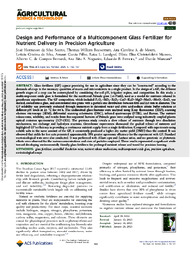Design and Performance of a Multicomponent Glass Fertilizer for Nutrient Delivery in Precision Agriculture.
Design and Performance of a Multicomponent Glass Fertilizer for Nutrient Delivery in Precision Agriculture.
Autoria: SOARES, J. H. da S.; BOAVENTURA, T. W.; MOURA, A. C. A. de; SILVA, L. C. da; GARCIA FILHO, A.; LANDGRAF, R. L.; MAZZEO, D. E. C.; BERNARDI, A. C. de C.; NOGUEIRA, A. R. de A.; FERREIRA, E. B.; MANZANI, D.
Resumo: Abstract: Glass fertilizers (GF) appear promising for use in agriculture since they can be "constructed" according to the demands of crops in the necessary quantities of macro and micronutrients in a single product. In the design of a GF, the different growth stages of a crop can be contemplated by considering the soil pH, irrigation regime, and composition. In this study, a multicomponent oxide glass is formulated for the nutritional Palisade grass (cv Piata), used as a model for nutrients released in greenhouse experiments. The GF composition, which included P2O5-SiO2-B2O3-CaO-K2O-MgO-MnO2-MoO3-ZnO, was melted, cooled into a glass, and comminuted into grains with a particle size distribution between 0.85 and 2.0 mm in diameter. The GF solubility was previously evaluated through immersion in deionized water and citric acid-sodium citrate buffer solutions at different pH levels at 25 degrees C for 64 h. The undissolved glass fractions were analyzed using X-ray fluorescence (XRF), scanning electron microscopy (SEM), differential scanning calorimetry (DSC), infrared spectroscopy (FTIR), and Raman. The nutrient release rates, solubility, and results from five sequential harvests of Palisade grass were analyzed using inductively coupled plasma optical emission spectrometry (ICP-OES). The previous study reveals a slow release of nutrients through two dissolution mechanisms, ion exchange and hydrolysis reactions. Greenhouse experiments showcased the gradual release of nutrients and highlighted GF's efficiency in providing a continuous nutrient supply from a single fertilization. Compared with experiments using soluble salts in the same amount of the GF, it consistently produced a higher dry matter yield (DMY) than the control. It was observed that yields for five cuts presented approximately 70% greater agronomic efficiency for the experiment with GF. Standard ecotoxicological tests were also conducted. It was performed with Allium cepa and Lactuca sativa, and no genotoxic or phytotoxic effects were observed for the various concentrations and sizes of particles employed. These results represented a significant stride toward developing environmentally friendly glass fertilizers for prolonged nutrient release and tuned for precision farming.
Ano de publicação: 2025
Tipo de publicação: Artigo de periódico
Unidade: Embrapa Pecuária Sudeste
Observações
1 - Por padrão são exibidas publicações dos últimos 20 anos. Para encontrar publicações mais antigas, configure o filtro ano de publicação, colocando o ano a partir do qual você deseja encontrar publicações. O filtro está na coluna da esquerda na busca acima.
2 - Para ler algumas publicações da Embrapa (apenas as que estão em formato ePub), é necessário ter, no celular ou computador, um desses softwares gratuitos. Sistemas Android: Google Play Livros; IOS: iBooks; Windows e Linux: software Calibre.
Acesse outras publicações
Acesse a Base de Dados da Pesquisa Agropecuária (BDPA) para consultar o acervo completo das bibliotecas da Embrapa.

